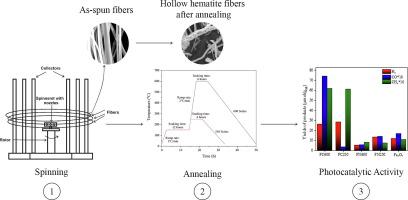Centrifugally spun hematite Fe2O3 hollow fibers: Efficient photocatalyst for H2 generation and CO2 reduction
IF 6.3
2区 材料科学
Q2 CHEMISTRY, PHYSICAL
引用次数: 0
Abstract
Mesoporous hollow hematite Fe2O3 fibers were successfully synthesized through centrifugal spinning and applied in photocatalytic H2 production and CO2 reduction. Fabrication of hollow hematite fibers includes two innovative synthetic steps: i) centrifugal spinning of precursor fibers using polyvinylpyrrolidone (PVP) as a polymeric part and two different Fe precursors (iron nitrate and iron chloride), ii) annealing of these fibers using different temperatures profiles (250 °C and 600 °C) with optimized heating rates and durations. The prepared samples (FN250, FN600, FC250, and FC600) were thoroughly characterized using SEM, XRD, XPS, and Raman spectroscopy, and the obtained results were correlated with the photocatalytic performance during H2 production and CO2 reduction. The FC250 and FC600 samples, which showed a higher concentration of oxygen defects, exhibited superior photocatalytic efficiency compared to the Fe2O3 standard. The enhanced performance is attributed to the increased light absorption, improved charge separation, and surface reactivity due to oxygen-related defects. These results highlight the potential of non-stoichiometric Fe2O3 nanofibers for environmental remediation and energy conversion applications.


赤铁矿Fe2O3离心纺丝中空纤维:产氢和还原CO2的高效光催化剂
采用离心纺丝法成功合成了中空赤铁矿Fe2O3介孔纤维,并将其应用于光催化制氢和还原CO2。空心赤铁矿纤维的制备包括两个创新的合成步骤:i)使用聚乙烯吡罗烷酮(PVP)作为聚合物部分和两种不同的铁前体(硝酸铁和氯化铁)对前体纤维进行离心纺丝;ii)在不同温度(250 °C和600 °C)下对这些纤维进行退火,并优化加热速率和持续时间。利用SEM、XRD、XPS和拉曼光谱对制备的FN250、FN600、FC250和FC600样品进行了全面表征,所得结果与制氢和还原CO2的光催化性能相关。与Fe2O3标准样品相比,具有较高氧缺陷浓度的FC250和FC600样品表现出更好的光催化效率。增强的性能归因于增加的光吸收,改进的电荷分离,以及由于氧相关缺陷的表面反应性。这些结果突出了非化学计量Fe2O3纳米纤维在环境修复和能量转换应用方面的潜力。
本文章由计算机程序翻译,如有差异,请以英文原文为准。
求助全文
约1分钟内获得全文
求助全文
来源期刊

Applied Surface Science
工程技术-材料科学:膜
CiteScore
12.50
自引率
7.50%
发文量
3393
审稿时长
67 days
期刊介绍:
Applied Surface Science covers topics contributing to a better understanding of surfaces, interfaces, nanostructures and their applications. The journal is concerned with scientific research on the atomic and molecular level of material properties determined with specific surface analytical techniques and/or computational methods, as well as the processing of such structures.
 求助内容:
求助内容: 应助结果提醒方式:
应助结果提醒方式:


